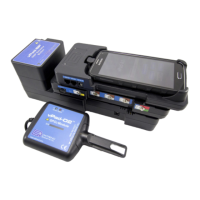vPad-A1 OPERATORS MANUAL
5.1.1 Sync Mode
Whenever the A1 is used as a completely assembled system, it is possible to synchronize the signals from all
three simulator modules by activating the control on the A1 Main screen. The Sync Mode feature
ensures that all heart signals are triggered simultaneously and share a common Heart Rate. Outside of Sync
Mode
, patient parameters may appear incorrectly timed on monitor displays with multiple traces.
Heart beat triggers are generated whenever a patient ECG Waveform is active. Therefore, the vPad-PS
module must be present in the system to make use of Sync Mode, and it must be set to simulate one of the
following:
• Normal Sinus Rhythm
• Arrhythmia
• Pacemaker Pulse
• Fetal ECG Signal
When Sync Mode is active, the shared Heart Rate setting can be managed from the ECG setup screen.
Controls for Heart Rate on all other modules will be disabled.
When running an AutoSequence in Sync Mode, the ECG Heart Rate will override all other modules in the
same AutoSequence Group. The A1 will display a warning if no ECG AutoSetting was added in the
AutoSequence to drive the synchronized heart beat.
5.1.2 Test Results and Records
When the simulation test setup is complete, whether through manual input (as described in chapter 4 -
Operation: Simulation Modules
) or an AutoSetting or AutoSequence (section 5.2 -
Test Automation
),
users can record the values observed on the Device Under Test (DUT). A custom Test Result interface can
be accessed with either the button or the button.
5.1.2.1 Creating Test Results
When displayed, the
Result screen will be specific to the type of simulation currently in use. It will
display all the settings and options that are active in the simulation. If there is a physiological
parameter that may be represented as a number on the DUT, an editable blue button allows a user to
enter that value as shown by the DUT. By default, on entering the Result screen such buttons are
initialized with corresponding settings from the A1 simulation in use.
In the example shown in
Figure 108
, the ECG Amplitude setting is
2.0 mV, which is shown as the default value in the editable blue
button. If the DUT indicates the ECG is only 1.75 instead of 2 mV,
the user can touch the button and then enter the DUT's reading.
Figure 108
Automation and Test Records/Chapter 5 # Page 74

